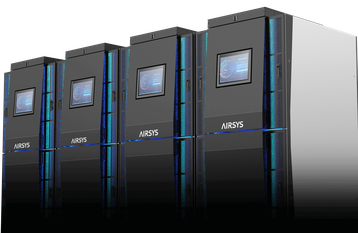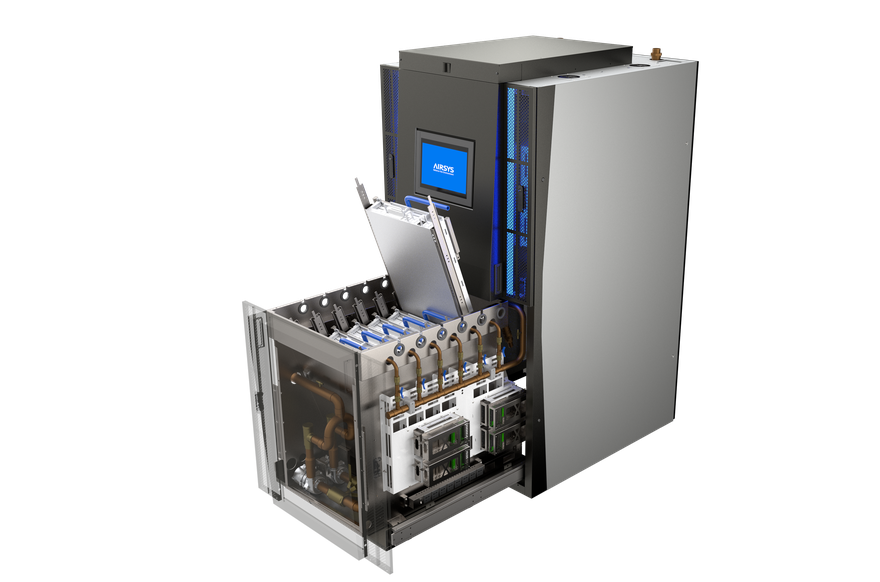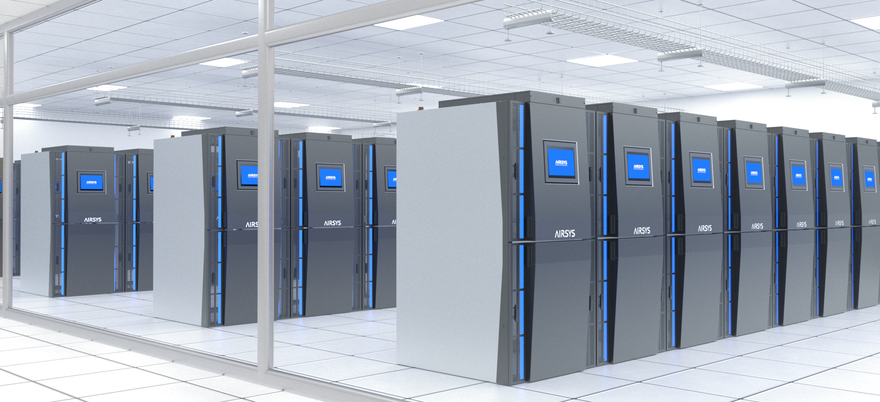It’s a common cliché that great inventions are often thought-up in the shower. But for Brad Chen, the idea behind spray cooling, the basis of Airsys’ Advanced Liquid Cooling Technology (ALCT) was, quite literally, dreamed up during just such a long, hot soak.
The conundrum he was thinking over? How to provide liquid cooling for power hungry, high density racks without all the faff involved with direct-to-chip water-based cooling, or dealing with conventional immersion technology, which require servers to be immersed in vast (and very heavy) vats of dialectric fluids, typically mineral oils.
“Air cooling struggles to provide cooling to the high-density racks being installed in data center halls today. So, we’ve been examining liquid cooling solutions, screening out many different potential solutions,” says Chen.
“Immersion cooling has become quite popular recently, but our research identified that spray might be one of the best ways to approach next-generation cooling, not just from a technical perspective, but also efficiency and serviceability.”
It was an idea, he says, that came to him in the shower. After his Eureka! moment, Chen and his team decided to investigate the potential for spray cooling more closely.
Exactly what it says on the tin
Spray cooling is exactly what the term indicates: servers arranged at around 75 degrees in specialist Airsys racks with the dielectric cooling solution sprayed directly on the hottest components, rather than fully immersing the whole server in such a liquid.
The cooling fluid is forcefully sprayed on the hot spots, like the GPU or CPU. The flow rate matches the heat load of the individual hot spot, and fluid momentum with the assistance of gravity flushing over the surface boosts the heat transfer coefficient several times higher again with the natural convection-based heat transferring to the solution.
The inclined installation of the servers ensures that the liquid flows along the motherboard down to the tank at the bottom, by which the motherboard will be isolated with air by running oil film to achieve higher reliability.
Thanks to the incline of the servers, there is no bypass fluid dropping directly into the sump, no splashing noises, no strong stirring required; everything happens smoothly and quietly.
It is also a service-friendly design with one-hand pushout for access. The cooling fluid, meanwhile, collects at in a small tank at the bottom, where it is put through a multiple stage filtration process, then fed through a heat exchanger at the back of tank to dissipate the heat for reuse.
Airsys’ spray cooling contrasts with both direct-to-chip liquid cooling and immersion cooling technologies. Direct-to-chip liquid cooling uses highly specialised racks to deliver cooling in the form of water direct to the chip in a loop. The waste heat is typically expelled into the hot aisle of the data center or to the external heat exchanger through secondary circulation.
Immersion cooling, meanwhile, involves immersing the entire rack of servers vertically in a dielectric fluid, normally a mineral oil.
Single-phase immersion cooling heavily relies on the thermal gradient induced buoyant force to drive the fluid circulating for the heat removal, while two-phase immersion cooling is even more complex, entailing a low-temperature evaporative process under the limits of critical heat flux for heat removal.
Moreover, single-phase immersion cooling can be challenged in terms of effective approaches to optimize flow to ensure that hotspots are efficiently cooled – especially taking into account different server designs and layouts. Airsys’ spray cooling can be adjusted to focus more cooling fluid direct to the hotspots, as required.
Spray cooling therefore offers multiple advantages over immersion cooling. First, of course, the cooling can be directed exactly where it is need. Second, accessing the servers is, quite simply, a much easier and less messy process, with minimal residual liquid for data center engineers to deal with. And, third, the orientation of the servers in Airsys LiquidRacks ensures a logical circulation of the cooling fluid in a motion that also makes it easier to capture and reuse the waste heat.
In addition, Airsys’ LiquidRacks occupy an 80 percent smaller footprint and, moreover, because the servers aren’t completely immersed in vast, heavy tanks of mineral oil, there are no potential excess floor weight issues to consider. Both these factors mean the data hall can accommodate more servers – and therefore more compute power – per square foot.
Direct-to-chip liquid cooling, meanwhile, uses water in racks similar to conventional data hall racks. Unlike Airsys’ spray cooling, it takes the cooling liquid direct to the chip. But, before access, the water needs to be shut off via valves in various places before the servers can be accessed, and even a minor leak would be catastrophic.
Airsys has developed its spray cooling technology with major server vendors, including Dell, HP and IBM, to ensure that it can handle the uneven heat distributions of different CPUs and motherboard combinations, and also uses conventional tried-and-tested dielectric liquids.
But these are not the only advantages.
Fair exchange
One of the key issues data center operators are grappling with right now is how to achieve their ambitious Net Zero promises, with many of them falling due in less than seven years’ time. The benefit of the various forms of liquid cooling is the efficiency with which waste heat can be captured for reuse compared to air cooling.
“How can we realize Net Zero? One solution is heat reuse. That means heat extracted from the server for heating, cooling or some other application. But how you do that is important. If the output temperature from the data center is only 40 or 50 degrees Celsius, the practical range of reuse applications is very small.
“But, for us, we can elevate output temperatures up to 60, 65 or even 70 degrees. This means that it can be output directly to, say, a district heating system because with fourth generation district heating systems the minimum temperature would be 60 degrees,” says Chen.
One of the keys to the efficacy of Airsys’ spray cooling technology is the delta between CPU temperature and the coolant’s exhaust temperature.
This is where it gets interesting. According to Airsys’ research, a CPU junction temperature of 65 degrees means a spray coolant temperature of 35 degrees. But at 85 degrees, the coolant temperature reaches the practical 60 degree threshold – a greater degree of heat capture than currently possible with immersion.
“Other solutions need to boost temperatures with things like heat pumps or boilers, but for Airsys with our direct connection there’s no need to lift up the output temperatures from spray cooling any further,” says Chen.
In other words, spray cooling not only enables CPUs and GPUs to be run at much higher wattages – and can efficiently cool them accordingly – but it effectively captures this heat on a rack-by-rack basis as the coolant is circulated.
Moreover, 60 degrees is a key temperature threshold. It’s the minimum temperature for hygienic hot water – killing Legionella bacteria within half-an-hour, for example – and the minimum starting temperature for absorption cooling and a range of processes based on thermodynamics.
In addition to the Airsys LiquidRacks that contain the servers, Airsys also supplies phase-change material thermal storage tanks, adsorption/absorption chillers capable of cooling between 5kW and 5MW, and dessiccant wheel dehumidifiers – everything required to start exporting and reusing excess data center heat.
Altogether, they provide a blueprint for a data center Net Zero solution matrix, depending on the size of the data center and the objectives the operator is hoping to achieve.
More research
Having developed the unique technology, Airsys is now taking it to market, with a testing lab at a major UK telecoms company and a demo lab in South Carolina – opening in the first quarter of 2024 – that will demonstrate the system’s complete data center energy solution.
One of the key areas for Chen and his team now is developing more efficient, lower viscosity cooling liquids. At the moment, Airsys uses the same kind of mineral oils typically deployed in immersion cooling; in this case, by industrial giant Shell.
“At this stage, we’re using a tried-and-trusted dielectric mineral oil base – the same that you would use in immersion cooling – because we don’t want to take any chances,” says Chen. However, he adds, a lower viscosity cooling fluid ought to enable a higher heat-transfer coefficient and, therefore, a more efficient cycle and therefore a greater cooling potential.
Perhaps that will be the next Eureka! moment for Chen – or someone else at Airsys – next time they’re in the shower?
To find out more about Airsys’ revolutionary new spray cooling system and how it can help data center operators achieve their ambitious Net Zero promises, please go to Airsys' dedicated Liquid Rack website
More from Airsys...
-

Sponsored Is cooling-as-a-service about to take off?
If you can buy a jet engine ‘as-a-service’, why not data center cooling? asks Airsys USA president Paul Quigley
-

Sponsored Interview: Airsys CEO Yunshui Chen on the changing cooling landscape
Airsys’ latest development is what it calls ‘cooling-as-a-service’ - data center cooling without the upfront capital expenditure
-

Sponsored Hot property: The cooling modular data centers need?
Modular data centers are finding homes in hospitals, banks, the military, and, of course, at the Edge. But will the critical cooling they need be up to the task?



